
The Atlanta Journal-Constitution is the only major daily newspaper in the metropolitan area of Atlanta, Georgia. It is the flagship publication of Cox Enterprises. The Atlanta Journal-Constitution is the result of the merger between The Atlanta Journal and The Atlanta Constitution. The two staffs were combined in 1982. Separate publication of the morning Constitution and the afternoon Journal ended in 2001 in favor of a single morning paper under the Journal-Constitution name.
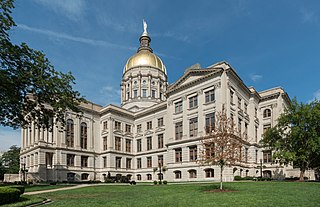
The Georgia State Capitol is an architecturally and historically significant building in Atlanta, Georgia, United States. The building has been named a National Historic Landmark which is listed on the National Register of Historic Places. As the primary office building of Georgia's government, the capitol houses the offices of the governor, lieutenant governor, and secretary of state on the second floor, chambers in which the General Assembly, consisting of the Georgia State Senate and Georgia House of Representatives, meets annually from January to April. The fourth floor houses visitors' galleries overlooking the legislative chambers and a museum located near the rotunda in which a statue of Miss Freedom caps the dome.

Henry Woodfin Grady was an American journalist and orator who helped reintegrate the states of the Confederacy into the Union after the American Civil War. Grady encouraged the industrialization of the South. He was praised by contemporaries and by authors Shavin and Galphin as a civic promoter, political strategist and captivating speaker, and by Atlanta journalist Frederick Allen as a visionary. However, in modern times, Grady's arguments for the need for white supremacy in the post–Civil War South have resulted in his legacy being seen as mixed and overtly racist. Grady's name has been removed from several schools including Atlanta's former Grady High School. Grady was the father-in-law of Federal Reserve Chairman Eugene Robert Black and grandfather of banker and World Bank President Eugene R. Black Sr.
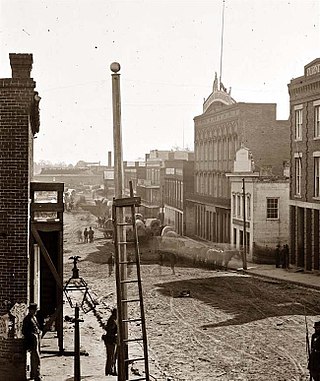
Marietta Street is a historic street in Downtown Atlanta. The street leads from Atlanta towards the town of Marietta, as its name indicates. It begins as one of the five streets intersecting at Five Points, leading northwest, forming the southern border of Downtown's Fairlie-Poplar district, continuing through Downtown's Luckie Marietta district, then entering West Midtown's Marietta Street Artery neighborhood, until terminating at its junction with West Marietta St., Brady Ave., and 8th St.
The McNeel Marble Works of Marietta, Georgia, was founded in 1892 by Morgan Louis McNeel and his brother, R. M. McNeel. Its location near the Blue Ridge Mountains provided the firm with access to areas where marble and granite could be quarried.

The DeKalb County Confederate Monument is a Confederate memorial that formerly stood in Decatur, Georgia, United States. The 30-foot stone obelisk was erected by the United Daughters of the Confederacy near the old county courthouse in 1908.
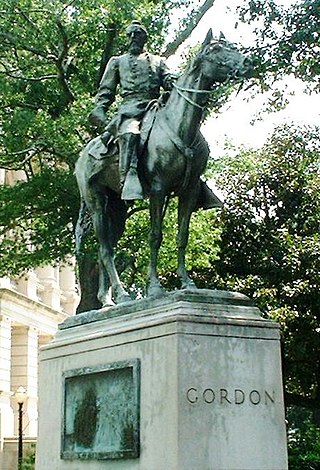
The equestrian statue of John Brown Gordon is a monument on the grounds of the Georgia State Capitol in Atlanta, Georgia, United States. The monument, an equestrian statue, honors John Brown Gordon, a general in the Confederate States Army during the American Civil War who later become a politician in post-Reconstruction era Georgia. Designed by Solon Borglum, the statue was dedicated in 1907 to large fanfare. The statue has recently become a figure of controversy over Gordon's racist views and associations with the Confederacy, with some calling for its removal.

The Martin Luther King Jr. statue is a public monument of civil rights activist Martin Luther King Jr. in Atlanta, Georgia. The statue, designed by Martin Dawe, was unveiled in 2017 and stands on the grounds of the Georgia State Capitol, overlooking Liberty Plaza.

Continuing the Conversation is a public sculpture honoring Rosa Parks in Atlanta, Georgia, United States. Located on the main campus of the Georgia Institute of Technology, the artwork was created by Martin Dawe and unveiled in 2018.

The Three Pioneers is a public sculpture on the main campus of the Georgia Institute of Technology. Created by Martin Dawe, the statue honors the first three African American students at the institute, who enrolled in 1961.

The First Graduate is a bronze sculpture at the Georgia Institute of Technology. Unveiled in 2019, the statue was designed by Martin Dawe and honors Ronald Yancey, the first African American student to graduate from the institute. The sculpture is located inside the Clough Undergraduate Learning Commons.
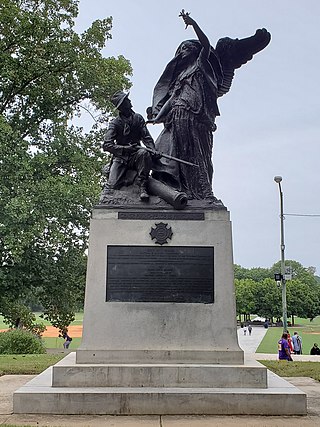
The Peace Monument is a public monument in Atlanta, Georgia, United States. Designed by Allen George Newman, the monument is located in Piedmont Park and was erected in 1911 by members of the Old Guard of the Gate City Guard, a Confederate-era militia, as a show of national unity in the years following the American Civil War. The monument has been the subject of controversy recently, with some calling for its removal as a symbol of the Lost Cause of the Confederacy.

The Eugene Talmadge statue is a public monument located on the grounds of the Georgia State Capitol in Atlanta, Georgia. Designed by Steffen Thomas, the statue was unveiled in 1949 and depicts Georgia Governor Eugene Talmadge. The statue has been the subject of recent controversy given Talmadge's white supremacist and racist views.

The Thomas E. Watson statue is a public monument located near the Georgia State Capitol in Atlanta, Georgia. Dedicated in 1932, the statue honors Georgian politician Thomas E. Watson, who served terms in the United States Congress as both a Representative and Senator in the late 1800s and early 1900s. Originally located on the steps of the capitol building, the statue was removed from this location in 2013 and relocated to a nearby plaza.
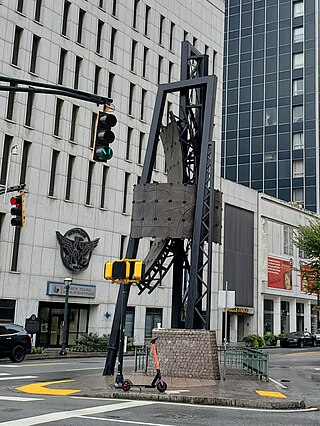
The Five Points Monument is a large public monument in Atlanta, Georgia, United States. Located in the Five Points district, the monument was designed by George Beasley and installed in 1996.
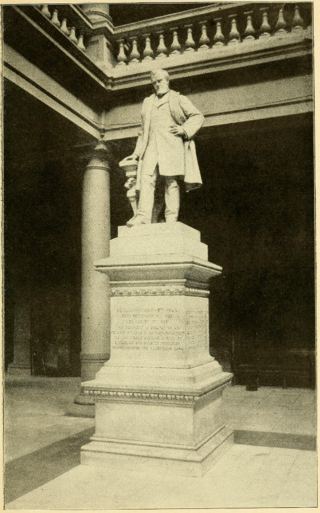
A statue of Benjamin Harvey Hill stands inside the Georgia State Capitol in Atlanta, Georgia, United States. The monumental statue was designed by American sculptor Alexander Doyle and originally dedicated in 1886 at what is now Hardy Ivy Park. The statue was relocated to the capitol building in 1890.

Hope Moving Forward is a public monument in Atlanta, Georgia, United States. Dedicated in 2021, the monument consists of a bronze statue of Martin Luther King Jr. designed by Basil Watson atop a pedestal. It is located at the intersection of Northside Drive and Martin Luther King Jr. Drive.

The George Floyd protests in Atlanta were a series of protests occurring in Atlanta, the capital and largest city of Georgia, United States. The protests were part of the George Floyd protests and, more broadly, the 2020–2021 United States racial unrest, which began shortly after the murder of George Floyd by police officer Derek Chauvin in Minneapolis on May 25, 2020. On May 26, protesting occurred in the Minneapolis–Saint Paul area and, over the next several weeks, protests spread to cities throughout the United States and then internationally.



















